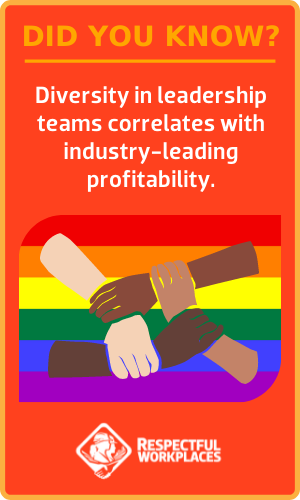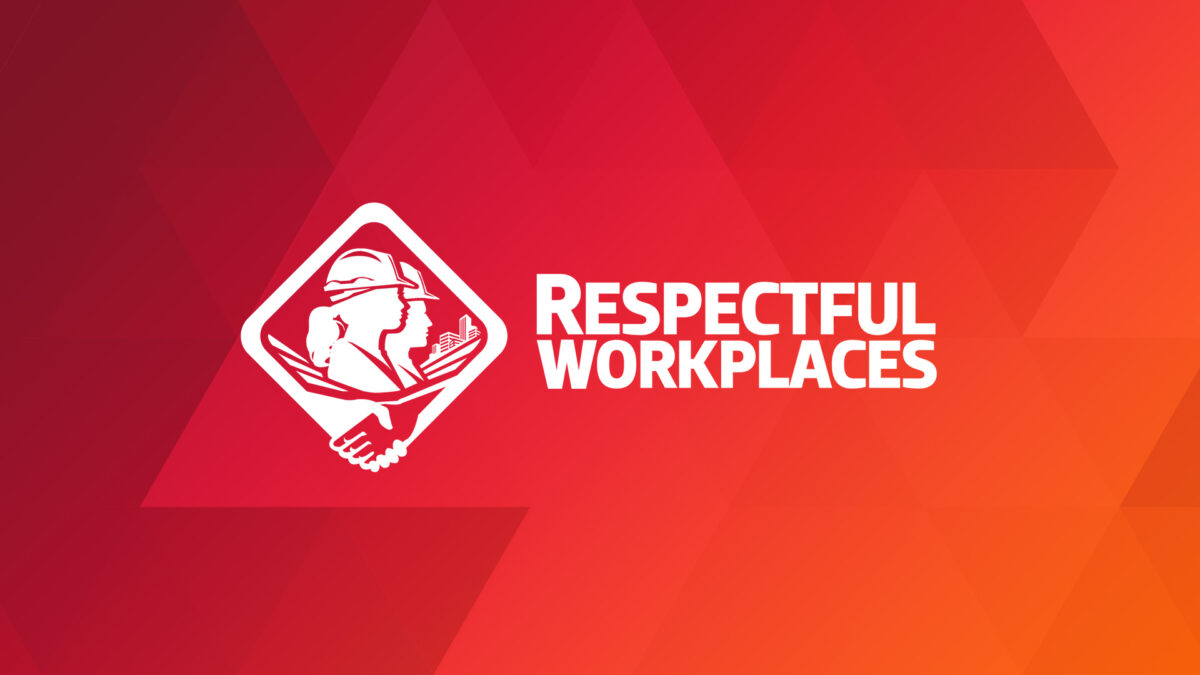Does your organization recognize and promote many forms of diversity in its leadership?

As we celebrate National Indigenous History Month and Pride Month in June, organizations may take this opportunity to examine their efforts to create workplaces and leadership teams that are respectful and inclusive of Indigenous and LGBTQ2S+ individuals.
An effective strategy for creating a respectful and inclusive workplace will target organization-wide change for all levels of workers. However, these efforts must facilitate inclusion in leadership in order to realize the full benefits of a respectful and inclusive workplace.
A recent study by the global consulting firm McKinsey found that a leadership team that includes women, LGBTQ+, and ethnically/culturally diverse individuals is strongly correlated with industry-leading profitability.
In their study, Delivering Through Diversity, (2018), McKinsey found that companies in the top quartile for ethnic/cultural diversity on executive teams were 33% more likely to have industry-leading profitability. This study went beyond their previous study in 2015 and included qualitative reviews of individual company’s initiatives regarding LGBTQ+ or age/generational diversity. The researchers suggest that given these findings, the inclusion of highly diverse individuals (e.g., LGBTQ+, age/generation) can be a key differentiator among companies.
Although correlation is not causation, the researchers believe that the correlation exists because companies with diverse leadership teams are better able to attract top talent, improve their customer orientation, maintain high levels of worker satisfaction and decision making, and secure their social license.
For organizations to facilitate the diversity in leadership needed to achieve industry-leading profitability and its benefits, barriers must be removed for all diverse groups, including Indigenous and LGBTQ2S+ people.
Barriers to inclusion for Indigenous people
Although many construction companies are making strides in developing partnerships with Indigenous communities, barriers to recruitment, retention, and advancement remain. An Environics study found that 71% of urban Aboriginal people in 11 Canadian cities believe that non-Aboriginal people have generally negative views about them.
Indigenous Works, a Canadian national social enterprise mandated to improve the inclusion of Indigenous people in the Canadian economy, reports some of the reasons why Indigenous people leave their jobs:
- Lack of motivation to advance an Indigenous workforce
- Racism
- Feel[ing] like the token Indigenous person
- No willingness [on the part of employers] to maintain a team
- Problem[s] with the supervisor
Barriers to inclusion for LGBTQ2S+ people
A study by the UK-based Architect’s Journal in 2015 found that lesbian, gay, and bisexual (LGB) workers in the construction industry experienced high levels of exclusion and homophobic comments. The researchers found that the highest number of reported incidents were in the contracting sector, and that these experiences were most prevalent on site.
In the study, the proportion of LGB construction employees who have heard homophobic comments in the workplace over the last 12 months was:
- Architecture: 59%
- Engineering: 61%
- Property: 63%
- Contracting: 85%
The study found that only one in 10 respondents would recommend the construction industry as a great place to work for gay men and women. One respondent said, “Attitudes on site are about 15 years behind attitudes in the office” and another said, “Homophobic banter is still considered harmless banter.”
Indigenous and LGBTQ2S+ people in leadership
A study by the Diversity Institute found that Indigenous and LGBTQ2S+ people are rarely members of boards. Interviews revealed the barriers to inclusion that they face, particularly in obtaining board positions: corporate culture; lack of social networks; discrimination, which is compounded for people who face multiple grounds of discrimination; pressures to refrain from self-identification; and a lack of mentorship or supports.
Conclusions
1. Line leadership matters.
Making culture change on work sites and in revenue-generating roles is a differentiating factor. The highest performing companies in the McKinsey study on both profitability and diversity had more women in line roles (i.e., typically revenue-generating) than in staff roles on their leadership teams.
2. Many forms of diversity matters.
Through qualitative reviews of individual company’s initiatives on other forms of diversity, e.g., LGBTQ+ or age/generational diversity, the McKinsey study suggests the same correlation with industry-leading profitability.
3. Leadership commitment.
It is impossible to overestimate the importance of visible and active leadership by committed leaders. They must develop and communicate a compelling vision for developing an effective talent pipeline of diverse individuals, including Indigenous and LGBTQ2S+ people, if they want to reap the full benefits of inclusion.
4. Cascade the commitment.
The vision must be cascaded throughout the organization to middle managers and site supervisors. Leading companies encourage role modelling and hold leaders and managers accountable.
From the research above, it’s clear that a strategy to create a respectful and inclusive workplace includes the long-term goal of creating a diverse leadership team that includes Indigenous and LGBTQ2S+ individuals. The benefits are not only industry-leading profitability, but also the ability to attract top talent, improve customer orientation, maintain high levels of worker satisfaction and decision-making, and secure your organization’s social license.
Leaders and managers who recognize the value of a respectful and inclusive workplace to their organization’s financial performance could consider participating in the Working in a Respectful and Inclusive Workplace course. It provides an understanding of the barriers to inclusion, and the skills needed for site supervisors and workers to navigate a diverse workplace.
For more info:
- Architect’s Journal. Survey results: Homophobia Remains Rife in Construction Industry. August 24, 2015.
- BuildForce Canada. Representation of Indigenous Canadians and Women in Canada’s Construction and Maintenance Workforce. 2018. See www.dev-bf-hub.pantheonsite.io/en/indigenous-people.
- Diversity Institute. Diversity Leads 2020: Diverse Representation in Leadership: A Review of Eight Canadian Cities. 2020. See www.ryerson.ca/diversity/reports/diversity-leads-diverse-representation-in-leadership-a-review-of-eight-canadian-cities.
- Diversity Works. “Why Do Indigenous People Leave Their Jobs?” See https://indigenousworks.ca/en/resources/getting-started/leave-jobs.
- Engineering News-Record. “After Years of Antipathy, Construction Puts Out Welcome Mat for LGBTQ Workers.” December 19, 2019. See www.enr.com/articles/48305-after-years-of-antipathy-construction-puts-out-welcome-mat-for-lgbtq-workers.
- Environics. Urban Aboriginal Peoples Study. April 30, 2010. See www.environicsinstitute.org/projects/project-details/urban-aboriginal-peoples-study.
- McKinsey. Delivering through Diversity. January 2018. See www.mckinsey.com/business-functions/people-and-organizational-performance/our-insights/delivering-through-diversity.
- Richard Chapman Harris. (n.d.). “Five Ways Construction Firms Can Bolster LGBT Inclusion.” See www.mottmac.com/views/five-ways-construction-firms-can-bolster-lgbt-inclusion.
Read from the beginning. Click here to start at Part 1.
What can an effective Respectful and Inclusive Workplace Program deliver?
- Become an employer of choice – attract, retain, and advance top talent from all sources of labour
- Unlock collaboration and innovation – create high-performing teams through diversity of thought and experience
- Build your brand – your organization will gain a competitive edge as a leader and innovator
Get started today!
The BuildForce Canada Online Respectful and Inclusive Workplace Toolkit includes:
- the Respectful Workplace Online Self-Assessment Tool to assist organization leadership in assessing their current situation and identifying where they may need to make changes
- the Respectful Workplace Policy Framework and Implementation Guide to assist organizations in creating and implementing a policy that supports a respectful and inclusive workplace
- the Respectful Workplace Online Training Course to train workers on how to create and support a respectful and inclusive workplace
- the online course Introduction to Understanding Systemic Racism: A Guide for Leaders and Managers
All the resources you need to create and support a respectful and inclusive workplace!

Respectful and Inclusive Workplaces
